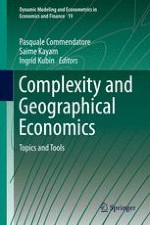2015 | OriginalPaper | Chapter
Spatial Interactions in Agent-Based Modeling
Authors : Marcel Ausloos, Herbert Dawid, Ugo Merlone
Published in: Complexity and Geographical Economics
Publisher: Springer International Publishing
Activate our intelligent search to find suitable subject content or patents.
Select sections of text to find matching patents with Artificial Intelligence. powered by
Select sections of text to find additional relevant content using AI-assisted search. powered by
